Chinese Woodcarving Art
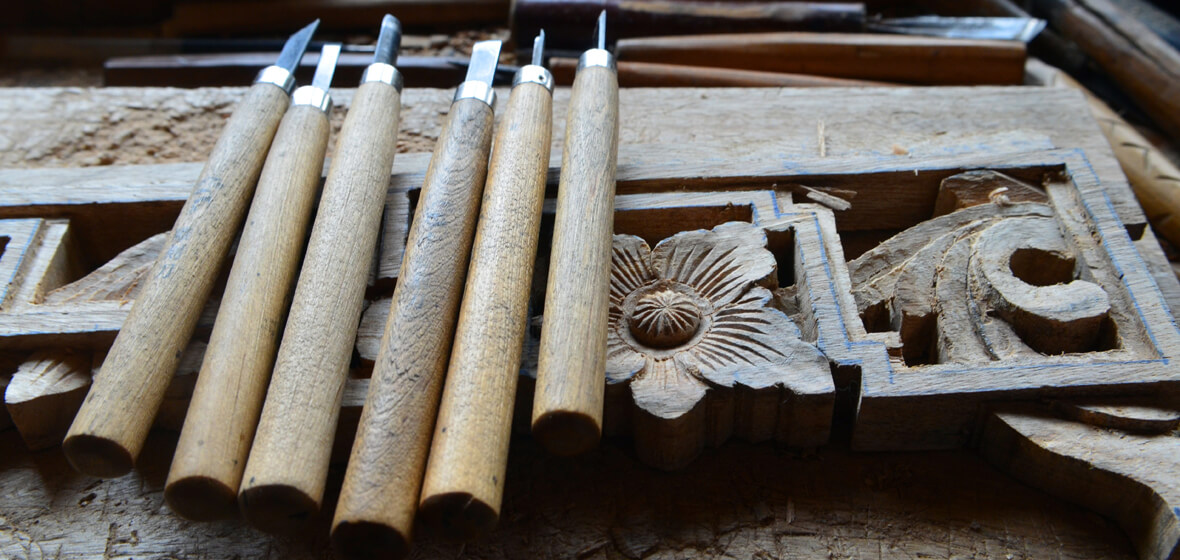
What is Chinese Wood Carving?
Woodcarving is one of the oldest and most important art forms in China, a craft steeped in history and tradition that reflects Chinese philosophy and culture. Traditional Chinese woodcarving shows great charm with its clever shapes and exquisite craftsmanship. Whether it is furniture, architectural decoration or interior decoration, the extraordinary artistic style of traditional woodcarving can be seen. Nowadays, Chinese woodcarvers continue to use wood as a medium to craft intriguing works of fine art, where only the imagination of the artist is the limit.
Table of Contents
What are the Different Types of Woodcarving in China? | 3 Categories of Chinese Wood Carving
In terms of its functions, Chinese woodcarving can be divided into three categories: woodcarving on buildings, woodcarving on furniture, and display artwork carving.
The Art of Woodcarving Embellishments on Architectural Structures
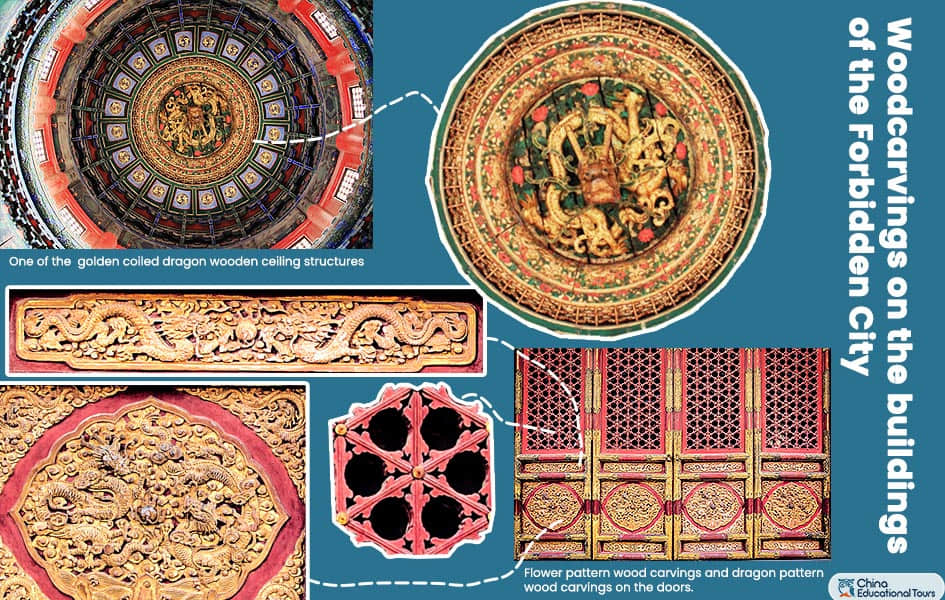
Woodcarving on buildings was used as decoration on gates, windows, beams, and pillars, etc. Wood carvings throughout the home serve as visual "lessons" concerning benevolence, righteousness, wisdom, loyalty, education, and so forth.
The Beauty of Woodcarvings on Furniture: A Timeless Art Form
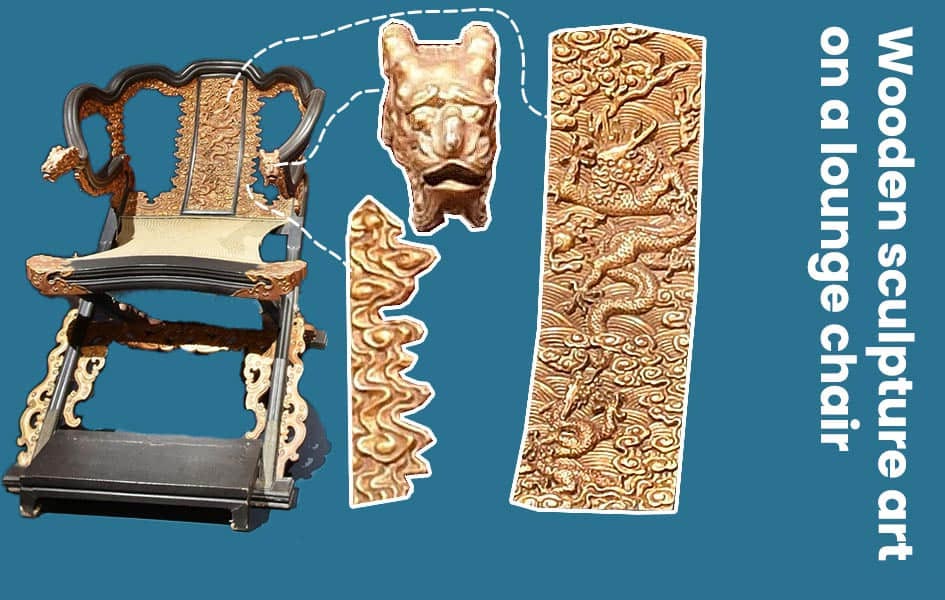
Woodcarving on furniture was used as decoration on screens, beds, chairs, dining tables, study desks, etc.
Display Artwork Carving: A Creative Exhibition

Display artwork carving: wood was carved into figures, animals, trees, flowers, etc.
The Main Techniques Used in Chinese Wood Carving Art
There are five main techniques used in Chinese woodcarving: line carving, relief carving, in-the-round carving, intaglio carving and hollowed-out carving.
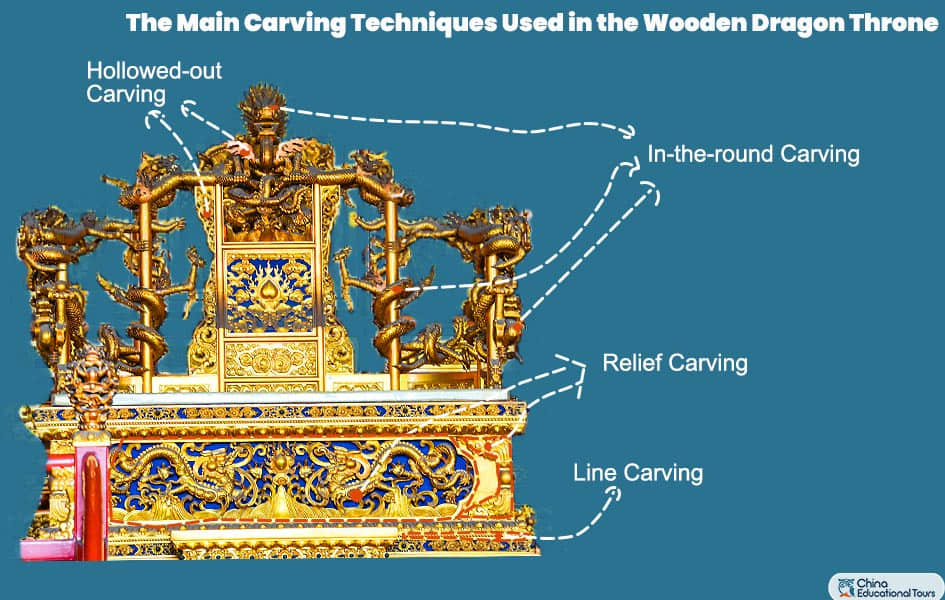
Line Carving
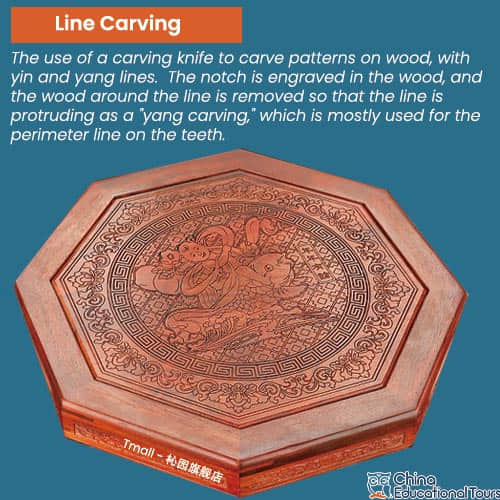
The use of a carving knife to carve patterns on wood, with yin and yang lines. The notch is engraved in the wood, and the wood around the line is removed so that the line is protruding as a "yang carving," which is mostly used for the perimeter line on the teeth. The slight changes in the depth, width, and narrowness of the line footing, and the height can produce different decorative effects, presenting different furniture styles, which are very dynamic.
Relief Carving
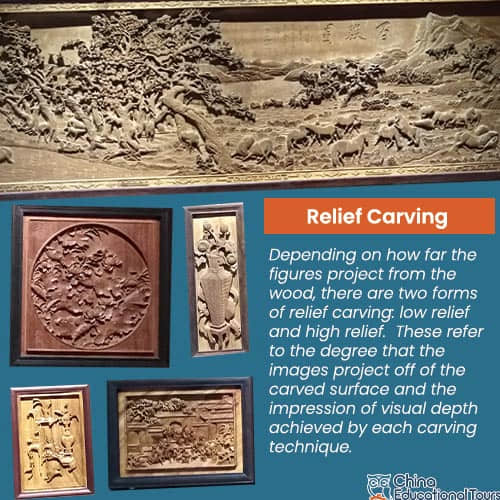
Involves carving figures and designs on a flat piece of wood so that it projects slightly from the surface, appearing three-dimensional to the viewer. Depending on how far the figures project from the wood, there are two forms of relief carving: low relief and high relief. These refer to the degree that the images project off of the carved surface and the impression of visual depth achieved by each carving technique.
In-the-round Carving
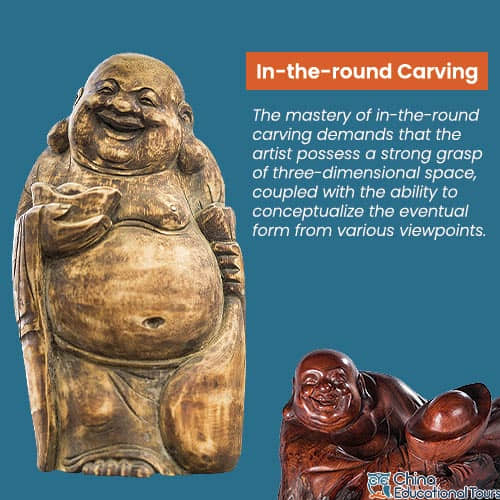
This technique produces three-dimensional pieces that can be viewed from all angles.
The mastery of in-the-round carving demands that the artist possess a strong grasp of three-dimensional space, coupled with the ability to conceptualize the eventual form from various viewpoints.
This technique has been employed by artists across history, from ancient civilizations to contemporary art, with the aim of providing a more interactive and immersive experience for the viewer. By enabling the viewer to walk around the sculpture and view it from different vantage points, in-the-round carving imbues the artwork with depth and dimensionality.
Examples of in-the-round carving can be found across various art forms, including sculpture, relief carving, and even certain forms of furniture design.
Intaglio carving
The design is cut into the wood surface.
Hollowed-out Carving
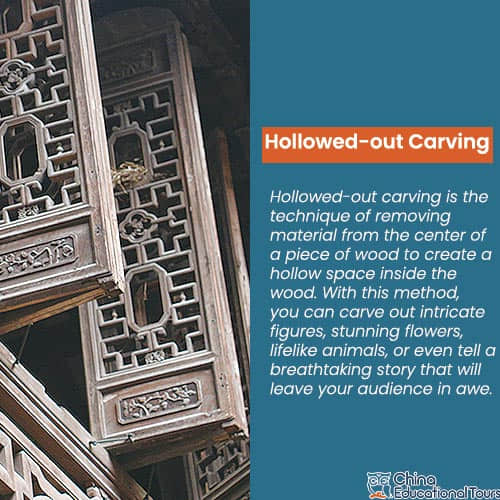
This involves removing material from the center of a piece of wood. This is usually done to create a hollow space inside the wood, such as figures, flowers, animals, or even to tell a story.
What is the Most Common Wood for Chinese Woodcarving?
Different types of wood have different properties that will affect the woodcarving. In general, firm trees with finer textures are used for carving, such as nanmu (Machilus nanmu), red sandalwood, camphorwood, cedar, gingko, agilawood, jujube, rosewood, and longan.
Of course, precious wood like nanmu is only for emperors or very rich families. The Forbidden City was originally constructed using nanmu wood by Ming Emperor Zhu Di. For common people, camphorwood, cedar, jujube, gingko, and longan were widely used.
Popular Patterns of Chinese Woodcarving and Their Meanings
There are many common patterns that you can find in woodcarvings, and those patterns are deeply influenced by Chinese philosophy and culture.
Popular Animal Patterns
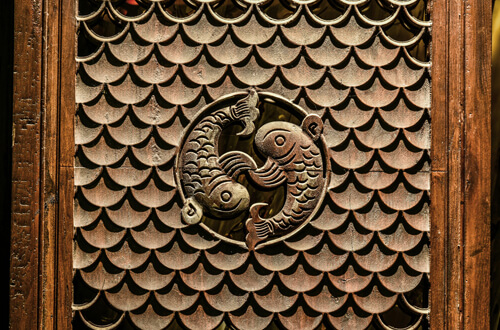
- Fish symbolizes unity, fidelity, abundance, and wealth.
- Deer symbolizes longevity and wealth.
- Bat symbolizes wealth because the Chinese word “bat” – “福 Fu” sounds like “prosperity, blessing, good luck.”
- The qilin or Chinese unicorn is a mythical beast that symbolizes good luck and prosperity.
- Horse symbolizes success and perseverance.
Popular Plants and Flowers Patterns
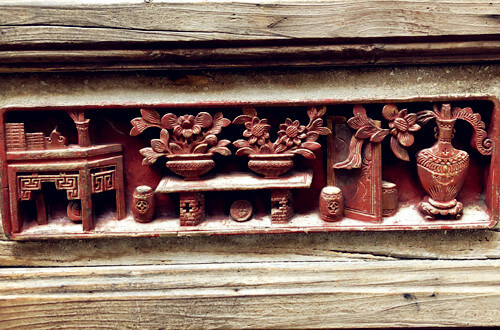
- Cabbage symbolizes wealth and prosperity.
- Bamboo symbolizes longevity, strength, and virtue.
- Peony symbolizes prosperity, good fortune, and happiness.
- Orchid symbolizes dignity, integrity, and friendship.
- Lotus flower symbolizes purity and innocence.
Popular Statue and Figurine Patterns
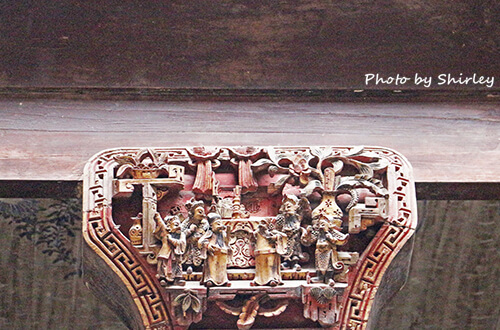
-
Laughing Buddha:
The statue of the Laughing Buddha usually depicts a portly individual with a large pot belly and a laughing face, sitting on a bed of coins. Chinese people believe that it brings joy and abundance. -
Guan Yin (Bodhisattva Avalokitesvara):
In China, the Guanyin symbolizes kindness and empathy. The Guanyin is usually shown as a beautiful, graceful young woman dressed in pure white robes. She wears a necklace with emblems of royalty that can be either Indian or Chinese in style. She often carries a jar of pure water and a willow branch; willow being used as a pain reliever in herbal medicine. -
Guan Yu:
A famous general at the end of the Han Dynasty era (206 BCE – 220 CE), Guan Yu is often displayed by businesses as a sign of trustworthiness and as a defender of their good name.
Carved Paintings
For woodcarving focused on architecture and furniture decoration, you can find carved paintings whose themes are fairy tales, legends, historical stories, stories from classic novels, and so on and so forth.
Famous Woodcarvings Around China
China has a wide range of woodcarvings distributed across the country. Zhejiang Dongyang woodcarving, Guangdong gold lacquer woodcarving, Yueqing boxwood carving, and Fujian longan woodcarving are the most popular ones and known as the “four most famous woodcarvings”. Huizhou woodcarving is famous for its carvings on buildings. Other varieties of woodcarvings include Qufu Pistache carving in Shandong Province; Nanjing antiqued woodcarving and Suzhou rosewood carving in Jiangsu Province; Jianchuan woodcarving in Yunnan Province; Shanghai woodcarving and Yongling birch woodcarving in Liang Province.
Dongyang Woodcarving
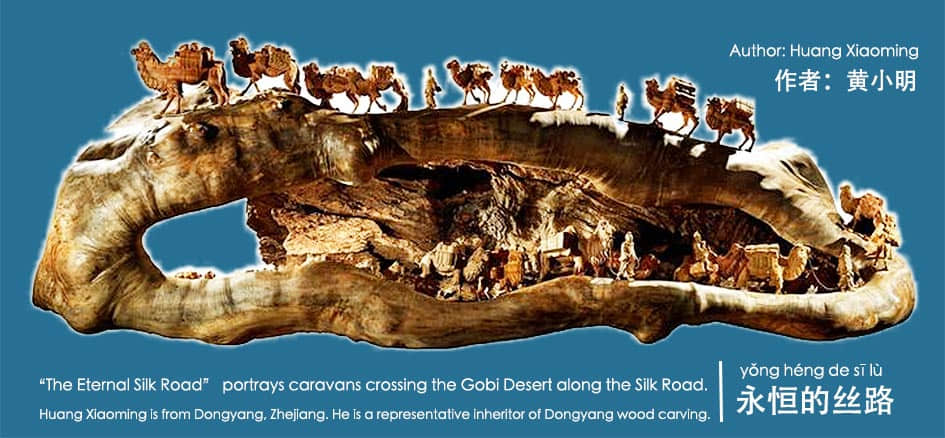
Dongyang woodcarving is one of the four famous Chinese carvings. It is one of the most outstanding folk crafts of the Chinese nation and is known as a “national treasure”. Dongyang woodcarving is an art that has been around since the Tang Dynasty (618-907), which began in the 7th century. This form of craftsmanship involves intricate wood sculpting that takes an incredible amount of time and dedication. The Chinese craft of Dongyang woodcarving is regarded by many to be one of the most elegant forms of relief carving in the world. The wood carving commonly appears as ornate decoration on “everyday” objects such as cases, cabinets, stools, desks, and tables.
Chaozhou Woodcarving
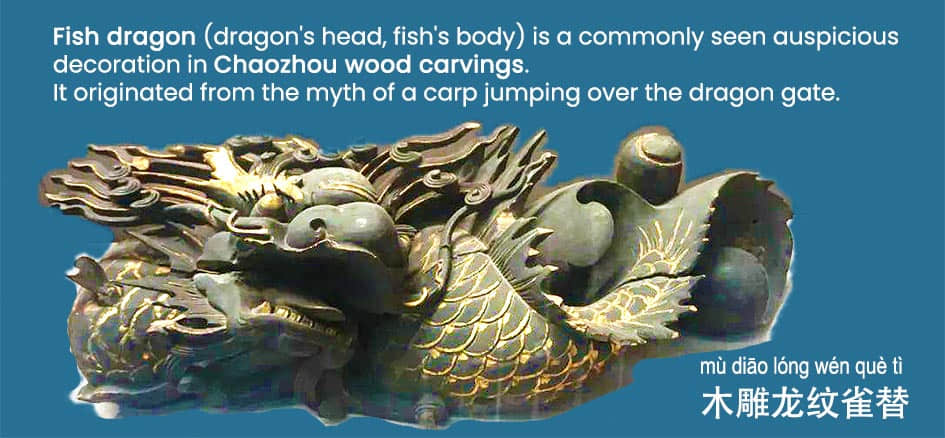 雀替 (què tì) is also called 梁角花 (liáng jiǎo huā ). It refers to the decorative patterns or designs that are typically found on the ridge beams and corners of traditional Chinese roofs. These designs are often intricate and colorful, and they are an important part of traditional Chinese architecture and culture.
雀替 (què tì) is also called 梁角花 (liáng jiǎo huā ). It refers to the decorative patterns or designs that are typically found on the ridge beams and corners of traditional Chinese roofs. These designs are often intricate and colorful, and they are an important part of traditional Chinese architecture and culture.
Chaozhou woodcarving is a folk carving art in Guangdong province, mainly used to decorate buildings, furniture, and sacrificial utensils. As lacquer and gold foil are often applied to Chaozhou woodcarving, it is also known as "gilt wood". It is one of the oldest surviving and most reputable forms of woodcarving in China, and is famous for its precision, sophistication, and lifelike sculptures.
Depicting everything from golden phoenixes and blossoming flowers to crabs struggling in fishing nets and rivals fighting in a martial arts contest, the craft captures the fine, complex details of images and moments in time.
Chaozhou woodcarvings can often be found on the doors, windows, and beams of temples and ancestral halls, on furniture such as partitions and cabinets, on ornaments, and on religious tools and vessels.
On May 20th, 2006, Chaozhou wood carving was included among the first batch of China's National Intangible Cultural Heritage list.
Yueqing Boxwood Carving
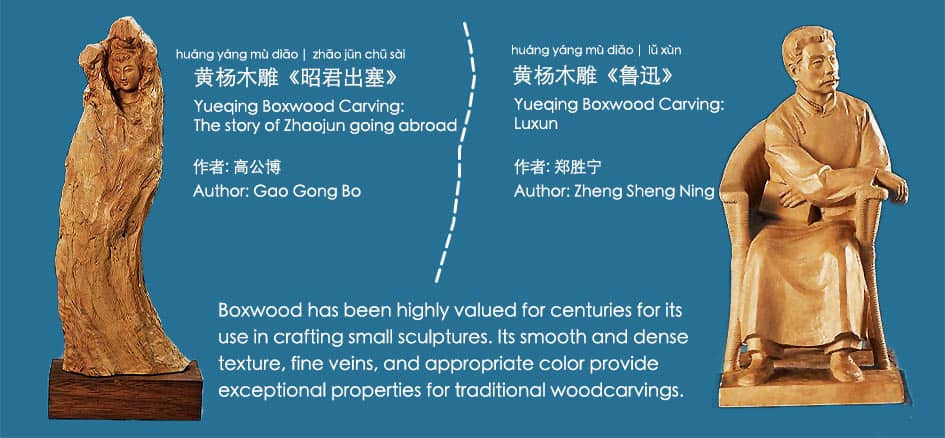
Boxwood has been prized since antiquity for the creation of small sculptures. These trees are known to be slow-growing evergreen shrubs, with their diameter reaching only around 15 centimeters after forty to fifty years, resulting in an ancient Chinese saying, "Box plants take more than a thousand years to grow up." Smooth and dense texture, fine veins, and proper color make them incredible materials for traditional woodcarvings.
Yueqing Boxwood carving, along with the woodcarving of the city of Dongyang as well as the stone carving of Qingtian County, is known as the "Three Carvings of Zhejiang". Their main subjects range from characters in folktales to those in classical Buddhist scriptures, including the Eight Immortals, Guan Yu, Maitreya, and Avalokitesvara, etc.
Fujian Longan Carving
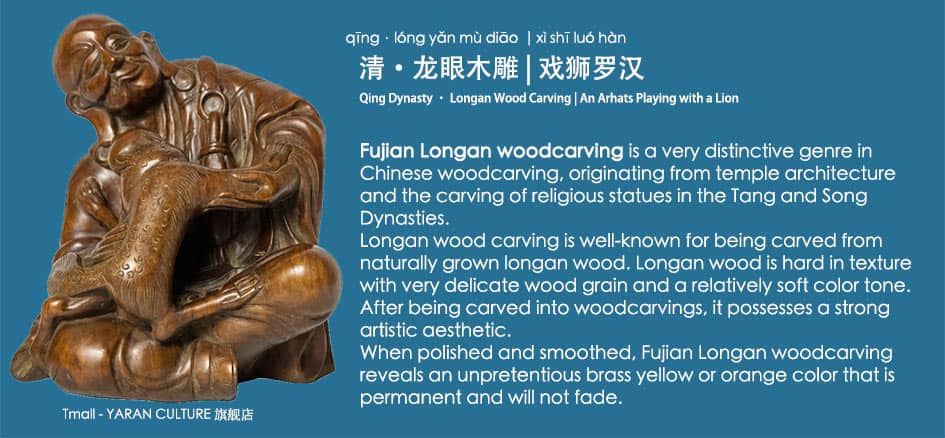 Fujian Longan woodcarving is a very distinctive genre in Chinese woodcarving, originating from temple architecture and the carving of religious statues in the Tang and Song Dynasties.
Fujian Longan woodcarving is a very distinctive genre in Chinese woodcarving, originating from temple architecture and the carving of religious statues in the Tang and Song Dynasties.
For most people, longan (Dimocarpus longan) is a sweet tropical fruit that you can find in China and southeastern countries. But for woodcarvers, the wood of longan (Euphoria longan) is good material for woodcarving. It is slightly brittle in texture, fine-grained, and reddish-brown in color. The longan mainly grows in the southern area of Fujian Province in China. The trunk, in particular, and the roots of old-age Longan, often grow to be either spectacular or grotesque in form, which is an ideal wood piece for engraving. Root carving, therefore, has become the unique variety of Fuzhou woodcarving. Local artisans, making the best use of its natural shape, by chopping with an axe or cutting with a chisel, have the twisted roots with their rough nodes carved into all sorts of figures, such as birds and beasts, in shapes that are vivid and artistically exaggerated. Fujian Longan woodcarving, when smoothed and polished, can reveal an unsophisticated brass yellow or orange color that will never fade. Besides longan, artisans also use boxwood, willow fir, yew wood, and camphor wood for woodcarving.
Huizhou Woodcarving
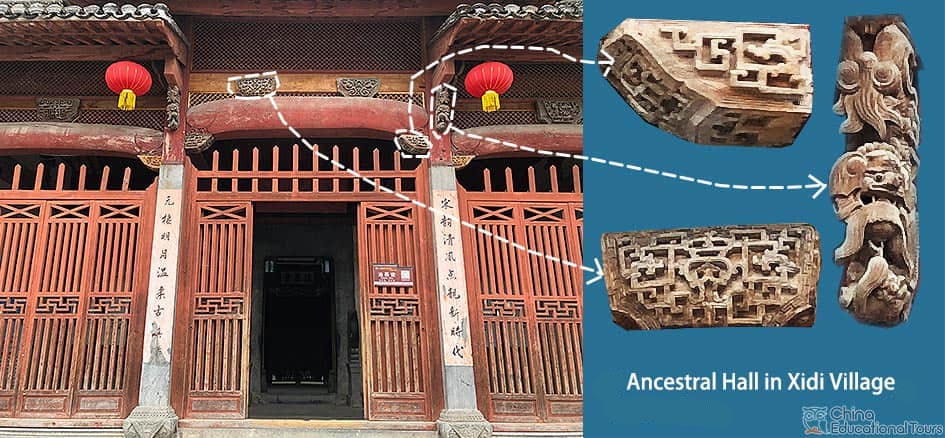 Huizhou woodcarving (徽州木雕 huī zhōu mù diāo) is one of the traditional folk carving arts, which together with Huizhou-style stone carving and brick carving, are collectively known as the "Three Huizhou Carvings".
Huizhou woodcarving (徽州木雕 huī zhōu mù diāo) is one of the traditional folk carving arts, which together with Huizhou-style stone carving and brick carving, are collectively known as the "Three Huizhou Carvings".
Huizhou is currently known as the Huangshan area in eastern China's Anhui Province. From the 15th to the 19th century, the Huizhou Merchants played an essential role in developing China's economy. The increasing wealth of these merchants led to the construction of lavish residences. Woodcarvings became popular ornaments for these structures and developed into a tradition in the Huizhou area. Huizhou woodcarving was particularly found on the baffle boards in the Tianjing courtyards. Tianjing, which literally means "heaven-well," is a protected courtyard and garden area that provides illumination and ventilation for the family. In addition, the windows on both sides of the main hall were also a venue for woodcarving artists to demonstrate their techniques and for the house owners to showcase their wealth.
The intricate wood engravings on roof beams, tables, chairs, and decorative wall panels were inspired by folk legends, poems, and stories that reflect Confucian etiquette, Buddhist teachings, and Daoist principles.
Soft tree species such as pine, China fir, camphor tree, nanmu (a kind of Phoebe), gingko, and others were used in Huizhou woodcarving. What Huizhou woodcarving emphasizes is not the quality of wood, but the content of the subject matter, the skills in carving, and the perfection of the composition and lines, which has had a great influence on the surrounding areas. You can still find many hundreds-year-old woodcarvings in ancient villages in Huangshan. Among these villages, UNESCO-listed Xidi and Hongcun have the best woodcarvings.
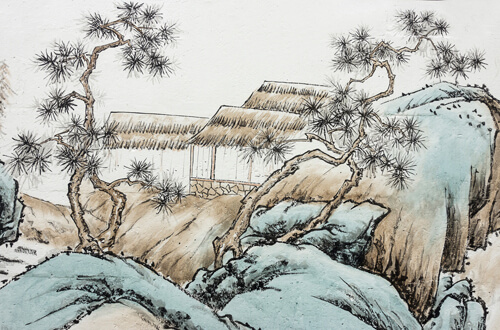 Chinese Painting
Chinese Painting 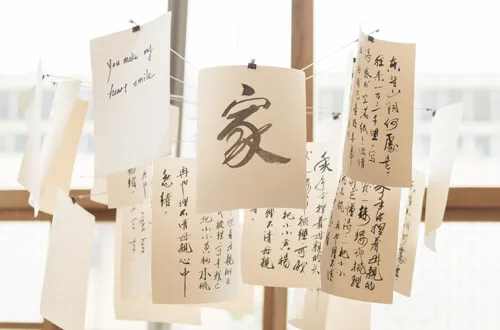 Chinese Calligraphy
Chinese Calligraphy  Chinese Kung Fu
Chinese Kung Fu 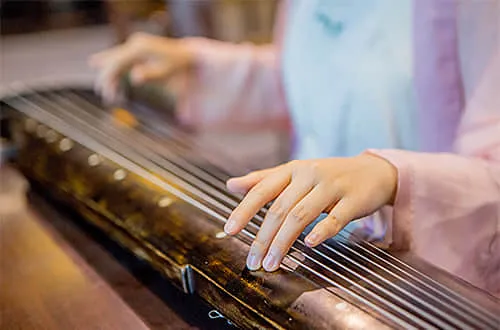 Chinese Music
Chinese Music